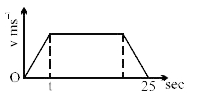A particle is moving east wards with a velocity of 15ms−1. In a time of 10 s, the velocity changes to 15ms−1 northwards. Average acceleration during this time is (in ms−2)Solution in Telugu
3/√2 NE
3/√2 NE
3/√2 NW
3/√2 NW
The correct Answer is:C
Step by step video & text solution for A particle is moving east wards with a velocity of 15 ms^(-1). In a time of 10 s, the velocity changes to 15 ms^(-1) northwards. Average acceleration during this time is (in ms^(-2)) by Physics experts to help you in doubts & scoring excellent marks in Class 12 exams.
Updated on:21/07/2023Similar Questions
A particle is moving east wards with a velocity of 5 ms^(-1) . In 10S the velocity changes to 5 ms^(-1) north wards. The average acceleration in this time is
View SolutionA particle is moving east wards with a velocity of 5ms−1, In 10 S, the velocity changes to 5ms−1 north wards. The average acceleration in this time is
View Solutionसरल रेखा में गति कर रहे कण का वेग समय वक्र चित्रानुसार है। त्वरण एवं मंदन की दर स्थिर है एवं 5ms−2 के बराबर है। यदि गति के दौरान औसत वेग 20ms−1 है तो t मान ज्ञात करों।

View SolutionA paricle is moving east wards with a velocity of 5 ms^(-1) . In 10S, the velocity changes to 5 ms^(-1) north wards. The average acceleration in this time is
View SolutionA particle is moving eastwards with a velocity of 5ms−1. In 10seconds the velocity changes to 5ms−1 northwards. The average acceleration in this time is
View SolutionA particle moves in the direction of east for 2s with velocity of 15ms−1. Then it moves towards north for 8s with a a velocity of 5ms−1. The average velocity of the particle is
View SolutionThe velocity- time graph of the particle moving along a straight line is shown. The rate of acceleration and deceleration is constant and it is equal to 5 ms^(-2) . If the average velocity during the motion is 20 ms^(-1) , then the value of t is
View SolutionA particle is moving eastward with a velocity of 5ms−1 If in 10 s the velocity changes by 5 ins northwari what is the average acceleration in this time?
View Solution
